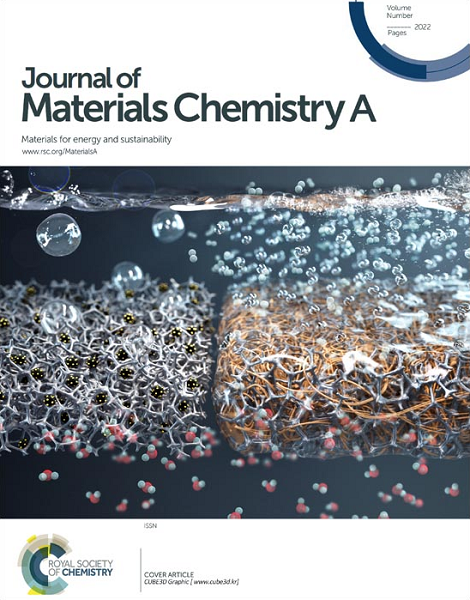通过计算筛选合理设计金属节点修饰的ti基mof用于二氧化碳选择性光还原为乙醇
IF 10.7
2区 材料科学
Q1 CHEMISTRY, PHYSICAL
引用次数: 0
摘要
本文通过密度泛函理论(DFT)计算,研究了将过渡金属(Mn, Fe, Co, Ni, Cu, Zn, Zr, Nb, Mo, Ru, Rh, Pd, Hf, Ta, W, Os, Ir, Au)引入到Ti-ATA (ATA = 2-氨基对苯二甲酸)中的一系列金属节点修饰的Ti-MOF催化剂,用于光催化将CO2还原为C2产物。在Ti(Nb)-ATA、Ti(Ta)-ATA、Ti(Zr)-ATA和Ti(Hf)-ATA上,两种*CHO进行C-C偶联形成重要的C2中间体*CHOCHO。Ti(Nb)-ATA和Ti(Ta)-ATA倾向于生成乙醇,而Ti(Zr)-ATA和Ti(Hf)-ATA对乙烯的选择性更强。在所研究的候选Ti(M)-ATA中,Ti(Nb)-ATA因其最小的极限自由能变化(1.12 eV)而被确定为CO2还原为乙醇最活跃的催化剂,其中*CH2CH2O还原为*CH2CH2OH是决定速率的步骤。相关曲线分析表明,Ti(M)-ATA催化剂的还原活性高度依赖于CO2与关键反应中间体如*OCHOH的结合强度。电子和光学性质分析表明,Ti(Nb)-ATA双金属节点周围的能带结构和电荷转移行为的改变是其具有优异的CO2还原乙醇催化活性的原因。本文章由计算机程序翻译,如有差异,请以英文原文为准。
Rational Design of Metal Node-modified Ti-Based MOFs for Selective Photoreduction of Carbon Dioxide to Ethanol by Computational Screening
In this work, density functional theory (DFT) calculations were conducted to investigate a series of metal node-modied Ti-MOF catalysts using transition metals (Mn, Fe, Co, Ni, Cu, Zn, Zr, Nb, Mo, Ru, Rh, Pd, Hf, Ta, W, Os, Ir, Au) introduced into Ti-ATA (ATA = 2-aminoterephthalic acid) for the photocatalytic reduction of CO2 to C2 products. CO2 can be sufficiently activated on Ti(M)-ATA but the adsorption configuration depends on the nature of M. Over Ti(Nb)-ATA, Ti(Ta)-ATA, Ti(Zr)-ATA and Ti(Hf)-ATA, the two *CHO species undergo C-C coupling to form *CHOCHO, the important C2 intermediate. Ti(Nb)-ATA and Ti(Ta)-ATA tend to generate ethanol, while Ti(Zr)-ATA and Ti(Hf)-ATA are more selective to ethylene. Among the Ti(M)-ATA candidates studied, Ti(Nb)-ATA was identified as the most active catalyst for CO2 reduction to ethanol due to its smallest limiting free energy change (1.12 eV), over which the *CH2CH2O reduction to *CH2CH2OH was found to be the rate-determining step. The correlation curve analysis illustrates that the reduction activity of Ti(M)-ATA catalysts is highly dependent on the binding strength of CO2 and key reaction intermediate such as *OCHOH. The analysis of electronic and optical properties indicates that the altered energy band structure and charge transfer behavior around the bimetallic nodes of Ti(Nb)-ATA account for its excellent catalytic activity for CO2 reduction to ethanol.
求助全文
通过发布文献求助,成功后即可免费获取论文全文。
去求助
来源期刊

Journal of Materials Chemistry A
CHEMISTRY, PHYSICAL-ENERGY & FUELS
CiteScore
19.50
自引率
5.00%
发文量
1892
审稿时长
1.5 months
期刊介绍:
The Journal of Materials Chemistry A, B & C covers a wide range of high-quality studies in the field of materials chemistry, with each section focusing on specific applications of the materials studied. Journal of Materials Chemistry A emphasizes applications in energy and sustainability, including topics such as artificial photosynthesis, batteries, and fuel cells. Journal of Materials Chemistry B focuses on applications in biology and medicine, while Journal of Materials Chemistry C covers applications in optical, magnetic, and electronic devices. Example topic areas within the scope of Journal of Materials Chemistry A include catalysis, green/sustainable materials, sensors, and water treatment, among others.
 求助内容:
求助内容: 应助结果提醒方式:
应助结果提醒方式:


